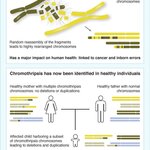Genetics & Molecular Biology

Scientists have grown the first 3-D mini lungs from stem cells, which means research is one step closer to being able to create one of the Big 5 organs from a patient's stem cells rather than having waiting lists for donors.
The University of Michigan scientists succeeded in growing structures resembling both the large proximal airways and the small distal airways.
Their recipe:
Embryonic stem cells
Proteins involved in lung development
Growth factors
Inhibitors of intestine development
Growing media
Petri dish
Protein mixture
Method for "morphogenesis in a dish"
First, add…

In a complex system like the human body, it's no surprise things can sometimes go wrong in development but evolution has made the system rather forgiving. When children inherit chromosomes from their parents, some minor genetic changes frequently occur without consequence but chromothripsis - chromosomal shattering - has been linked to severly affected children of healthy mothers in a small study.
The researchers studied three families whose children suffer from multiple abnormalities due to chromothripsis that they inherited from their mothers. Although the children's mothers were unaffected…

Living beings can keep gene expression in check, which might partly explain the uncontrolled gene expression found in many cancers, according to a new paper/
"Using yeast as a model organism, we studied the Tup1 protein, a negative regulator of gene expression," says Biology Professor Emanuel Rosonina. "This protein binds to some genes and blocks their expression, helping to ensure genes that shouldn't be turned on remain inactive."
The paper suggests that Small Ubiquitin-like Modifier (SUMO) modifies proteins bound to active genes, in order to prevent unfettered gene over-expression…

A team of scientists have successfully transferred a receptor that recognizes bacteria from the model plant Arabidopsis thaliana, a dicot, to wheat, a monocot.
The receptor can trigger a defensive response and confers increased resistance to bacterial disease. The research findings demonstrate that the signaling pathways or circuitry downstream of the receptor are conserved between evolutionary distant monocots and dicots.
Drs. Henk-jan Schoonbeek and Christopher Ridout, lead and corresponding authors of the paper, first developed diagnostic tools which tests wheat for responses to…

Would you want to know if you or your children had risk of hereditary cancer, a genetic risk for cardiovascular disease or carried the gene associated with developing Alzheimer's disease - even if they were risks that wouldn't be relevant for possibly decades or didn't have a cure?
Researchers used data from a cross-sectional online survey of a nationally-representative sample of the U.S. population that was conducted as part of the C.S. Mott Children's Hospital National Poll on Children's Health and found that 80 percent showed the same interest in genome sequencing for themselves as…

Rosacea is estimated to affect up to 16 million people in the United States alone, with symptoms typically including redness, visible blood vessels, and pimple-like sores on the skin of the central face.
Because rosacea affects facial appearance, it can also have a psychological impact on those who suffer from it, according to surveys by the National Rosacea Society.
A new paper studied the data of more than 46,000 23andMe customers and found two genetic variants strongly associated with the disease among people of European ancestry. 23andMe has controversially claimed in the past that…

Statins are associated with increased risk for diabetes, though it is unclear why. One hypothesis is that statins increase expression of LDL receptors and increase cholesterol uptake into cells including the pancreas, which could cause pancreatic dysfunction. Familial hypercholesterolemia causes decreased LDL transport into cells and researchers have hypothesized that with familial hypercholesterolemia, decreased pancreatic LDL transport would lessen cell death and ultimately lead to lower rates of diabetes.
A new analysis finds that type 2 diabetes among 25,000 patients with familial…
It was good to be a rampaging Mongol warlord circa 1200 A.D. - at least when it came to having a lot of sex and killing off your genetic rivals.
But he was not the only one. A new study finds that millions of Asian men share a common ancestral heritage with 11 people dating back 4,000 years ago. The study examined the male-specific Y chromosome, which is passed from father to son, in more than 5,000 Asian men belonging to 127 populations. Though most Y-chromosome types are very rare, the team discovered 11 types that were relatively common across the sample and studied their…

Imagine a pair of twins that everyone believed to be estranged who end up closer to each other than anyone knew.
It may be just like that at the cellular level. We have two copies of each gene, one from each parent, and each copy, called an "allele," remains physically apart from the other in the cell nucleus.
Except a new study finds that is not always the case - at least in one set of alleles in mammalian cells. And the pairing has been observed to coincide with a critical time in the life of a stem cell: the moment when it commits to develop into a specific cell type, called…

Why can cancer cells be so resilient, even when faced with the onslaught of nearly toxic drug cocktails, radiation, and even our own immune system?
A new research report appearing in the March 2015 issue of The FASEB Journal, shows that intermediate filaments formed by a protein called "vimentin" or VIF, effectively "insulate" the mitochondria in cancer cells from any attempt to destroy the cell. Under normal circumstances, VIF serves as the "skeleton" for cells by helping them maintain their shapes.
In some cancer cells, however, VIF actually help to preserve the cancer cell's center of…